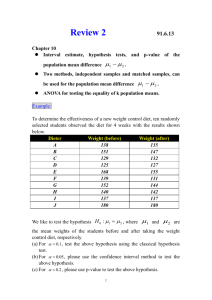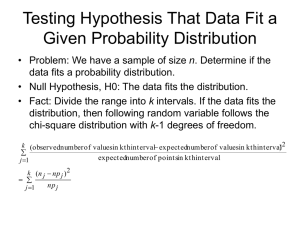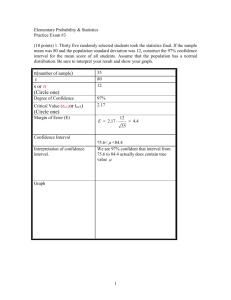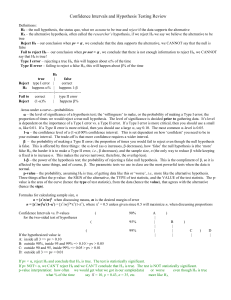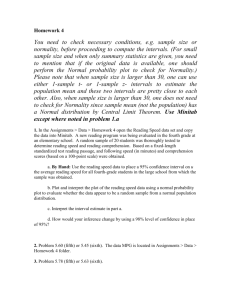252y0312
advertisement
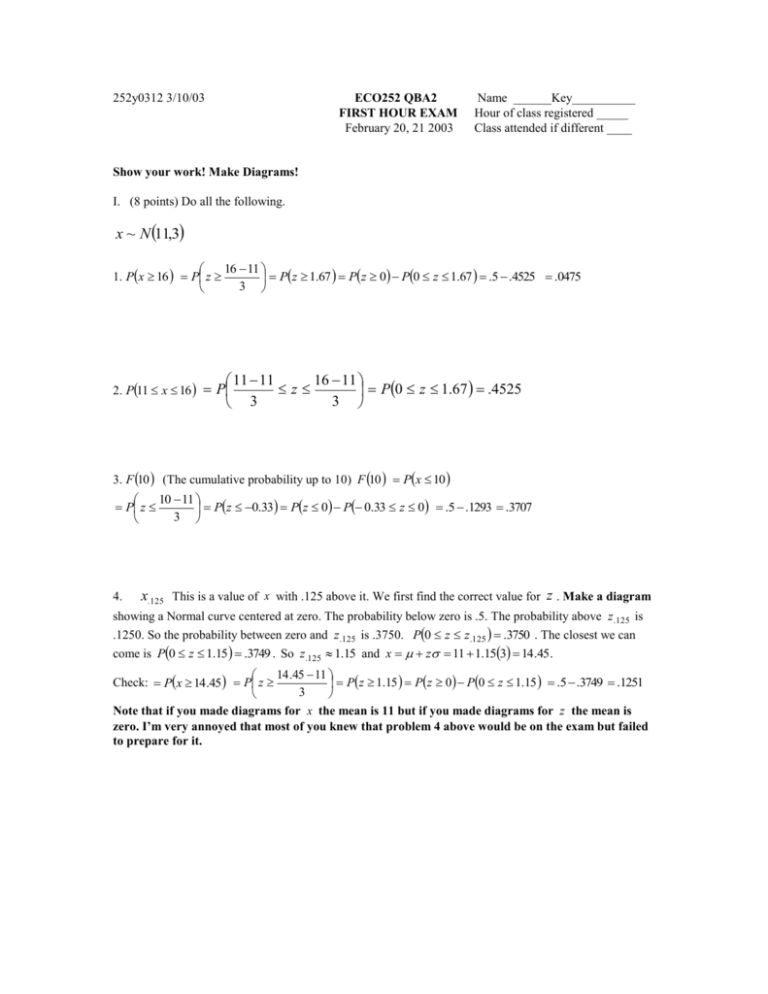
252y0312 3/10/03 ECO252 QBA2 FIRST HOUR EXAM February 20, 21 2003 Name ______Key__________ Hour of class registered _____ Class attended if different ____ Show your work! Make Diagrams! I. (8 points) Do all the following. x ~ N 11,3 16 11 1. Px 16 P z Pz 1.67 Pz 0 P0 z 1.67 .5 .4525 .0475 3 16 11 11 11 z P0 z 1.67 .4525 3 3 2. P11 x 16 P 3. F 10 (The cumulative probability up to 10) F 10 Px 10 10 11 P z Pz 0.33 Pz 0 P 0.33 z 0 .5 .1293 .3707 3 4. x.125 This is a value of x with .125 above it. We first find the correct value for z . Make a diagram showing a Normal curve centered at zero. The probability below zero is .5. The probability above z .125 is .1250. So the probability between zero and z .125 is .3750. P0 z z.125 .3750 . The closest we can come is P0 z 1.15 .3749 . So z.125 1.15 and x z 11 1.153 14 .45. 14 .45 11 Check: Px 14.45 P z Pz 1.15 Pz 0 P0 z 1.15 .5 .3749 .1251 3 Note that if you made diagrams for x the mean is 11 but if you made diagrams for z the mean is zero. I’m very annoyed that most of you knew that problem 4 above would be on the exam but failed to prepare for it. 252y0312 3/10/03 II. (6 points-2 point penalty for not trying part a.) A random sample is taken of the endowments of private colleges in the US. The following data is found. College 1 2 3 4 Endowment ($Millions) 60 47 235 3909 a. Compute the sample standard deviation, s , of the endowments. Show your work! (3) b. Compute a 99% confidence interval for the mean endowment, .(3) Solution: a) Index x x2 1 47 2209 2 60 3600 3 235 55225 4 3909 15280281 Total 4251 15341315 x 4251 x 1062 .75 , s n 4, x 15341315 41062 .75 2 n 4 n 1 3 s 1899 .354 10823564 .75 949 .718 3607854 .92 . So s 3607854.92 1899.354 and s x 3 n 4 b) The formula for a confidence interval is x t n1 s . .01, so use t 3 5.841. The confidence 2 2 nx 2 2 x .005 interval is 1062 .75 5.841949 .718 1062 .75 5547 .30. Make a diagram including the upper and lower limits for the mean or note that P4485 6610 .99 . 2 252y0312 3/10/03 III. Do all of the following Problems (17 points) Show your work except in multiple choice questions. 1. Which of the following would be an appropriate null hypothesis (1)? a) The population proportion is less than 0.65. b) The sample proportion is less than 0.65. c) *The population proportion is no less than 0.65. d) The sample proportion is no less than 0.65. Note that a hypothesis (i) contains equalities and (ii) deals with a population. Question: How many of you looked at ‘Things You Should Never Do on an Exam or Anywhere Else’ before this exam? It should alert you to problems like the first two here. TABLE 9-1 Microsoft Excel was used on a set of data involving the number of parasites found on 46 Monarch butterflies captured in Pismo Beach State Park. A biologist wants to know if the mean number of parasites per butterfly is over 21. She will make her decision using a test with a level of 0.10. The following information was extracted from the Microsoft Excel output for the sample of 46 Monarch butterflies: n = 46; Arithmetic Mean = 29.00; Standard Deviation = 25.92; Standard Error = 3.82; Null Hypothesis: H 0 : 21 .000 ; = 0.10; df = 45; T Test Statistic = 2.09; One-Tailed Test Upper Critical Value = 1.301; p-value = 0.021; Decision = Reject. 2. Referring to Table 9-1, the parameter the biologist is interested in is (1): a) the mean number of butterflies in Pismo Beach State Park. b) the mean number of parasites on these 46 butterflies. c) *the mean number of parasites on Monarch butterflies in Pismo Beach State Park. d) the proportion of butterflies with parasites. Note that a parameter refers to a population. 3. Referring to Table 9-1, Mark the following true or false (3): a) The null hypothesis would be rejected if a 5% probability of committing a Type I error is allowed. T b) The null hypothesis would be rejected if a 2% probability of committing a Type I error is allowed. F c) The null hypothesis would be rejected if a 1% probability of committing a Type I error is allowed. F Repeat after me: If a p-value is below the significance level, reject the null hypothesis. 4. Referring to Table 9-1, state the alternate hypothesis for this study (1). Answer: H1 : 21 .000 3 252y0312 3/10/03 5. The marketing manager for an automobile manufacturer is interested in determining the proportion of new compact-car owners who would have purchased a passenger-side inflatable air bag if it had been available for an additional cost of $290. The manager believes from previous information that the proportion is 0.30. Suppose that a survey of 200 new compact-car owners is selected and 76 indicate that they would have purchased the inflatable air bags. If you were to conduct a test to determine whether there is evidence that the proportion is different from 0.30, which test would you use? (1) 2 a) -test of population variance. b) z-test of a population mean c) *z-test of a population proportion d) t-test of population mean 6. In problem 5, using a 5% significance level when appropriate: H : p .30 a) State the null and alternative hypotheses (2) Solution: 0 H 1 : p .30 b) Do the problem using a test ratio (3) Solution: From the formula table we have: Interval for Confidence Hypotheses Test Ratio Critical Value Interval Proportion p p0 p p z 2 s p pcv p0 z 2 p H 0 : p p0 z H1 : p p0 p pq p0 q0 sp p n n q 1 p q 1 p 0 .05 . n 200 . p z p p0 p 0 p0 q0 x 76 .30 .70 .380 . .00105 .02340 . p n 200 n 200 .380 .30 3.42 . This is a 2-sided test. Make a diagram. Show a Normal curve with a mean .02340 at zero and rejection zones (shaded) above z .025 1.960 and below z .025 1.960 . Since your value of z is above 1.960, reject H 0 . c) Find a p-value for the test ratio (1) Solution: pval 2Pz 3.42 2Pz 0 P0 z 3.42 2.5 .4997 .0006 . Note that a p-value must be between zero and one. pq .380 .620 d) Do the problem using a confidence interval (2) Solution: s p n 200 .001178 .03432. p p z 2 s p .380 1.960.03432 .380 .067 , or .313 to .447. Since p 0 .30 is not in this interval, reject H 0 . e) Do the problem using a critical value for a proportion (2) Solution: pcv p0 z p , 2 p .02340 p cv .30 1.960 .02340 .30 .046 , or .253 to .346. Since p .380. is not in this interval, reject H 0 . Or Make a diagram. Show a Normal curve with a mean at .30 and rejection zones (shaded) above .346 and below .253. Since p .395. is above .253, reject H 0 . f) (Extra credit) Remember what you did on page 1 and do e) again using a 25% significance level (2) Solution: pcv p0 z p . .25 . z z.125 1.15 . 2 2 p cv .30 1.15.02340 .30 .027 , or .273 to .327. We still reject H 0 . 4 252y0312 3/10/03 7. We believe that the standard deviation for household income per year in Hooverville is $2900. We take a sample of n 150 households and find a sample standard deviation of $2600. a) Test the hypothesis that the population standard deviation is $2900 assuming that the underlying distribution is Normal. (2) b) (Extra credit) Do a confidence interval for the population standard deviation.(2) c) (Extra credit) Test the hypothesis that the population standard deviation is less than $2900. (2) Solution: From the formula table (but the outline is better) Interval for Confidence Hypotheses Test Ratio Critical Value Interval VarianceH 0 : 2 02 n 1s 2 n 1s 2 n 1s 2 2 2 2 Small Sample cv 02 .25.5 2 .25 .5 2 H1: : 2 02 s 2DF z VarianceH 0 : 2 02 Large Sample z 2DF 2 2 2DF 1 H1 : 2 02 2 We use the lower group of formulas because of the large value of n 150 . Assume .05 . H 0 : 2900 n 1s 2 149 2600 2 119 .7669 . a) Only the test ratio method is normally used. 2 02 2900 2 H 1 : 2900 DF n 1 149 . z 2 2 2 DF 1 2119 .7669 2149 1 15 .4768 17 .2337 1.757 . Make a diagram. Show a Normal curve with a mean at zero and rejection zones (shaded) above z .025 1.960 and below z .025 1.960 . Since your value of z is not below -1.960, do not reject H 0 . b) 2 DF 2149 17 .2627 s 2 DF z 2 2 DF 2600 17 .2627 . Since 1.960 17 .2627 2600 17 .2627 2600 17 .2627 2334 .9 and 2933 .0 , we can say 2334 .9 2933 .0 . 1.960 17 .2627 1.960 17 .2627 H 0 : 2900 c) Oh, let’s go for broke. I’ll do it 3 ways. OK, I’ve never seen it done 3 ways before. H 1 : 2900 Test ratio method: Use the value of z that you computed above. Small values of s result in small values of z , so make a diagram. Show a Normal curve with a mean at zero and a rejection zones (shaded) below z .05 1.645 . Since your value of z is below -1.645, reject H 0 . 2 Critical value method: cv s reversed. s cv n 1s 2 .25.5 2 2 DF z 2 2 DF won’t work, so try the confidence interval formula with and We want a lower critical value, so use s cv 2 DF z 2 DF 2900 17 .2627 2648 .3 Make a diagram. Show a Normal curve with a mean at 2900 and a rejection 1.645 17 .2627 zones (shaded) below 2648.3. Since your value of s is below 2648.3, reject H 0 . 5 252y0312 3/10/03 H : 2900 s 2 DF Confidence interval method: 0 We have . If we look at the alternate H : 2900 z 2 2 DF 1 hypothesis, we want a confidence interval that gives an upper limit to . s 2 DF z 2 2 DF 2600 17 .2627 2873 .9 . Since it is impossible that 2873 .9 and 2900 1.645 17 .2627 are both true, reject H 0 . It’s remarkable how many of you decided that the H 0 in the proportions problem was .30 and in the standard deviation problem was 3000 . Were you asleep? 6 252y0312 3/10/03 ECO252 QBA2 FIRST EXAM February 20, 21 2003 TAKE HOME SECTION Name: _________________________ Social Security Number: _________________________ IV. Do the first two problems (at least 10 each) (or do sections adding to at least 20 points - Anything extra you do helps, and grades wrap around) . Show your work! State H 0 and H 1 where appropriate. You have not done a hypothesis test unless you have stated your hypotheses, run the numbers and stated your conclusion. Use a 95% confidence level unless another level is specified. 1. (Kazmier) You want to be sure that the set-up time for new equipment is not more than 9 minutes for each hour of operation. From a random sample of 40 hours selected from the records of another company that has already bought the equipment, we find a sample mean of 10.09 minutes. Assume a population standard deviation of 3.00 minutes. Use a 99% confidence level. a) State your null and alternative hypotheses. (1) b) Find a critical value for the sample mean and specify where your ‘reject’ region is (a diagram is suggested) (1) c) Do you reject the null hypothesis? Show why. (1) d) Create a power curve for this test. (6) e) Do a 2-sided confidence interval for the mean (1) f) (Extra credit) It is possible to determine the required sample size in a one-sided test for the mean given certain levels of the probability of type I and a type II error. If 0 is the population mean from the null hypothesis and we want to be able to keep the probability of a type II error to when the mean is actually 1 , use the following sample size: n z z 2 2 1 0 2 . Assume that .01 , .05 and that 1 9.1. Show that we will need a much larger sample size than was proposed. (3) Solution: a) Our hypotheses were H 0 : 9 and H1 : 9 . The problem said n 40 , x 10 .09 , 3.00 and .01 , we can use z z.01 2.327 . b) From the formula table we have: Interval for Confidence Interval Mean ( x z 2 x known) Hypotheses Test Ratio H0 : 0 z H1 : 0 x 0 x Critical Value xcv z 2 x This is a one-sided test, so we are only worried about values of the sample mean above 9 . We use 3.00 x 0.4743 . Because of the alternate hypothesis, we wanted a critical value above 9, so we n 40 used xcv z x 9 2.327 0.4743 10.10. c) Make a diagram with a Normal curve centered at 9 and a reject zone above 10.10. Since x 10.09 is not in the ‘reject’ zone, we do not reject H 0 . Lots of you said not to reject H 0 because xcv 10.10 is above 9. Given H1 : 9 , the critical value will be above 0 whether H 0 is true or false. 7 252y0312 3/10/03 d) Half of the distance between 9 and 10.10 is 0.55, so I add this to 0 9 four times and find the power at 1 9, 1 9.55, 1 10 .10, 1 10 .65, and 1 11 .20 . Remember that Power 1 , and that P Not rejecting H 0 H 0 is false . We do not reject H 0 if x is less than or equal to the critical x 1 10 .10 1 value of 10.10, so Px 10 .10 1 P z cv We get the . Pz 0.4743 x following: 10 .10 9 1 9 : P z Pz 2.32 .5 .4898 .99 . power 1 .01. You don’t have to 0.4743 do this one since you learned in class that if 1 0 , 1 and power . 1 9.55 : Pz 10 .10 9.55 Pz 1.16 .5 .3770 .8770 . power 1 .1230 0.4743 10.10 10.10 1 10 .10 : P z Pz 0 .5. You don’t have to do this one since you learned in 0.4743 class that if 1 xcv , .5 and power .5. 10.10 10.65 1 10 .65 : Pz Pz 1.16 .5 .3770 .1230 . power 1 .8770 0.4743 10.10 11.20 1 11 .20 : Pz Pz 2.32 .5 .4898 .0102 . power 1 .9898. 0.4743 You now have the power for 5 points above or equal to 9. Make a diagram. Put zero through one on the yaxis and 9 to 11.5 on the y-axis. e) The confidence interval has the formula x z s x . Since .01 , we know that 2 z 2 z.005 2.576. Recall that x 10.09 and x 3.00 0.4743 . So n 40 10.09 2.576 0.4743 10.09 1.222 or 8.87 to 11.29. Many of you seem to think that we were testing the hypothesis H 0 : 10 .09 . This is impossible because 10.09 is a sample mean. Using the formula for critical values for this hypothesis gets you the right answer for a very wrong reason and is only worth half credit. f) (Extra credit) It is possible to determine the required sample size in a one-sided test for the mean given certain levels of the probability of a type I and a type II error. If 0 is the population mean from the null hypothesis and we want to be able to keep the probability of a type II error to when the mean is actually 1 , use the following sample size: n z z 2 2 1 0 2 . Assume that .01 , .05 and that 1 9.1. Solution: The original problem says that 3.00 and that 0 9. This part says that .01 , .05 and that 1 9.1. So z z.01 2.327 and z z.05 1.645 . n z z 2 2 2.327 1.645 2 32 1 0 2 9.1 92 14199 .1 . So our sample size is 14200. 8 252y0312 3/10/03 2. (Kazmier) A company takes a random sample of 100 men in a large community and finds that 42% prefer its blades. a) Create a 95% confidence interval for the proportion that favor the blade. (2) b) How large a sample would we need if the proportion must be known within .05 ? (3) c) Assume that the company is testing the hypothesis that the proportion is greater than or equal to 45%, find a critical value for the sample proportion and use it to test the hypothesis using the data at the beginning of this problem. (2) d) What would the p-value be in for your hypothesis in c) if (i) the sample proportion was .44 and (ii) the sample proportion was .46? (3) e) (Extra credit) Assume that the actual proportion is 43%, what is the power of the test in c)? (3) Solution: From the formula table we have: Interval for Confidence Hypotheses Interval Proportion p p z 2 s p H 0 : p p0 pq n q 1 p sp H1 : p p0 a) The problem says that .05, n 100 , and p sp Test Ratio z p p0 p Critical Value pcv p0 z 2 p p0 q0 n q0 1 p0 p x .42 . q 1 p .58. z 2 z.025 1.960. n pq .42 .58 .002436 .0494 . p p z 2 s p .42 1.960.0494 .42 .097 or .323 to n 100 .517. b) The sample size formula appears in the outline and says n is .42 or .5. n .42 .58 1.960 2 .05 2 pqz 2 e2 It doesn’t make much difference if p 374 .3 , so we use n 375 . With .5 we get 385. H 0 : p .45 x c) q0 1 p0 1 .45 .55 . .05, n 100 , and p .42 . n H 1 : p .45 p0 q0 .45.55 .002475 .0497 . The critical value formula is pcv p0 z p , but since 2 n 100 the alternate hypothesis alleges that the proportion is below .45, we use pcv p0 z p .45 1.645.0497 .45 .082 .368. Make a diagram showing a Normal curve with p a mean at .45 and a ‘reject’ region below .368. Since .42 does not fall in the ‘reject’ region, do not reject H 0 . Many of you said to accept or reject H 0 because p cv is below .45. But the critical value would be below .45 whether the null hypothesis was true or false. 9 252y0312 3/10/03 p p0 . We already know that p .0497 . Since the alternate hypothesis p alleges that the proportion is below .45, we are only worried about values of p below .45. Such values will make z negative. We are thus interested in the probability of getting the value of p that we actually get, d) The test ratio formula is z or something smaller. (i) If p .44, z p p0 p .44 .45 .20 , so that .0497 pval P p .44 Pz .20 .5 .0793 .4207 . (ii) If p .46, z p p0 p .46 .45 .20 , so .0497 that pval P p .46 Pz .20 .5 .0793 .5793 . e) In c) we said to make a diagram showing a Normal curve with a mean at .45 and a ‘reject’ region below .368. Power 1 , and that P Not rejecting H 0 H 0 is false . We do not reject H 0 if p is less than or equal to the critical value of .368. The problem says to assume that the actual proportion is 43%, so p1 .43 and P p .368 p .43 If we assume that p .43, we must have p0 q0 .43.58 .002494 .0499 , though using .047 shouldn’t make much difference. n 100 .368 .43 Pp .368 p .43 P z Pz 1.24 .5 .3925 .1075 . .0499 Power 1 1 .1075 .8925. p 10 252y0312 3/10/03 3. A new product assembly system is introduced and we are trying to find out if the median number of units assembled per workshift is larger than the 80 units per workshift we got under the old system. The following data is assembled on the number of units assembled in a workshift. 75, 85, 92, 80, 94, 90, 91, 76, 88, 82, 96, 83 a) Test the hypothesis that the median is above 80 at the 5% level. (4) b) (Extra credit) Use the second highest number and the second lowest number to create a twosided confidence interval and find its significance level. (3) c) Lets say that you had a sample of 150 numbers and that 100 were above 80. Repeat a). (2) d) (Extra credit) If you have 150 numbers and took two numbers at an equal distance (in Order) from the highest and lowest to create an approximately 95% confidence interval for the median, what would they be? Solution: It’s remarkable how many of you thought that this question concerned the mean. There is no point in answering a question that you haven’t read! H 0 : 80 a) The numbers in order are (75, 76, 80, 82, 83, 85, 88, 90, 91, 92, 94, 96). . Let p be the H 1 : 80 H : p .5 proportion above 80. then, according to the outline, the hypotheses become 0 . n 12 and, H 1 : p .5 under the null hypothesis, we expect half, or less than half of the numbers to be above 80. We should drop the 80 and revise n so that n 11 . There are x 9 numbers above 80 and pval Px 9 1 Px 8 1 .96729 .0371 . Since .05 and pval , we reject H 0 . b) It is questionable whether to drop the 80 in this case. If we do not drop the 80, the interval is 76 94 . This interval is wrong if eleven or more numbers are above the median, or eleven or more numbers are below the median. For n 12 , we have 2Px 11 21 Px 10 21 .99976 2.00024 0048 . If we choose to drop the 80, n 11 and we have 2Px 10 21 Px 9 21 .99951 .00980 . H 0 : p .5 x c) Again , but, this time n 150 and x 100 . Then p .6667 . Because of the large H : p . 5 n 1 sample, no continuity correction is needed and p z p p0 p .5.5 pq .040825 . We use n 150 .6666 .5 4.07 . Since this is larger than any value of z from the bottom of the t-table, we .040825 reject H 0 . d) We can copy this answer from the outline. The interval is x63 x x88 . 11



